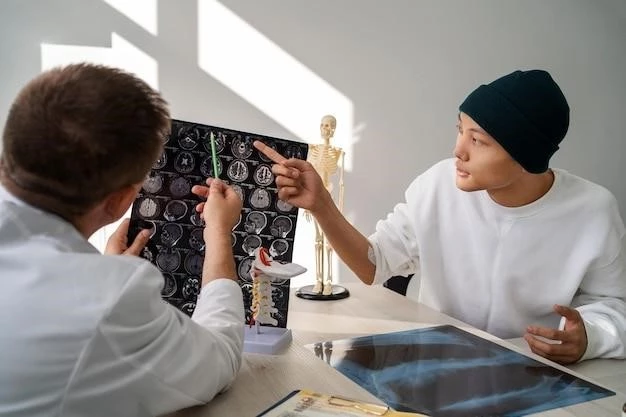Disease — Hyperostosis Corticalis Generalisata
Welcome! This article discusses Hyperostosis Corticalis Generalisata, a rare skeletal disorder. Learn about symptoms, diagnosis, pathology, and treatment options. Stay informed about this condition to better understand its impact and management. Let’s explore together!
Introduction
Welcome to an overview of Hyperostosis Corticalis Generalisata, a rare skeletal disorder characterized by abnormal bone growth. This condition, also known as van Buchem disease, affects the skeletal system, leading to increased bone density. Hyperostosis Corticalis Generalisata is a genetic disorder that causes thickening of the outer layer of bones, resulting in deformities and potential complications.
Individuals with this syndrome may experience a range of symptoms such as bone pain, fractures, and skeletal deformities. Early diagnosis and understanding of the genetic basis of the disorder are crucial for effective management. In this article, we will explore the symptoms, diagnosis, pathology, types, rare cases, complications, treatment options, prognosis, and long-term management of Hyperostosis Corticalis Generalisata. Understanding this condition is essential for individuals affected by it, as well as healthcare providers involved in their care.

Symptoms and Signs
Hyperostosis Corticalis Generalisata presents various symptoms and signs related to abnormal bone growth. Individuals with this rare disorder may experience bone pain, particularly in the limbs, skull, and spine. Fractures are common due to the increased bone density, making bones more susceptible to breaking.
Skeletal deformities, such as an enlarged jaw or thickened skull bones, can occur in some cases. Limitations in joint movement and muscle weakness may also be observed. In severe instances, compression of nerves or blood vessels by enlarged bones can lead to additional complications.
Recognizing the symptoms and signs of Hyperostosis Corticalis Generalisata is vital for prompt diagnosis and appropriate medical management. If you or someone you know is experiencing unexplained bone pain, consistent fractures, or noticeable skeletal changes, consult a healthcare professional for evaluation and guidance. Early detection can help in devising a suitable treatment plan and improving the long-term outlook for individuals affected by this skeletal syndrome.
Diagnosis
Diagnosing Hyperostosis Corticalis Generalisata typically involves a combination of clinical assessments, imaging studies, and genetic testing. Healthcare providers may conduct a thorough physical examination to evaluate skeletal abnormalities, bone pain, and limitations in movement. X-rays, CT scans, or MRI scans are commonly used to visualize the bone structures and identify areas of increased density.
Genetic testing plays a crucial role in confirming the presence of specific genetic mutations associated with Hyperostosis Corticalis Generalisata. Identifying these genetic abnormalities can provide valuable insights into the underlying cause of the disorder and help in predicting disease progression.
It is essential to consult with a medical professional if you suspect symptoms of Hyperostosis Corticalis Generalisata or have a family history of the condition. Early diagnosis allows for timely intervention and management strategies to minimize the impact of this skeletal disorder. By seeking appropriate medical care and undergoing the necessary diagnostic procedures, individuals with Hyperostosis Corticalis Generalisata can receive personalized treatment and support tailored to their specific needs.
Pathology and Genetic Basis
The pathology of Hyperostosis Corticalis Generalisata involves excessive and abnormal bone formation, particularly affecting the outer layer of bones. This results in thickened cortical bone, leading to increased bone density and bone overgrowth. The genetic basis of this rare disorder is linked to mutations in the SOST gene, which encodes for a protein called sclerostin.
Sclerostin normally functions to inhibit bone formation. Mutations in the SOST gene disrupt this regulatory mechanism, causing uncontrolled bone growth and density. The overproduction of bone tissue, especially in the cortical bone layer, contributes to the characteristic features of Hyperostosis Corticalis Generalisata.
Understanding the pathology and genetic basis of this condition is essential for developing targeted therapies and interventions. By unraveling the molecular mechanisms behind Hyperostosis Corticalis Generalisata, researchers can explore novel treatment approaches that focus on modulating bone growth and density to improve patient outcomes and quality of life.
Types of Hyperostosis Corticalis Generalisata
Hyperostosis Corticalis Generalisata, also known as van Buchem disease, manifests in different forms, each with varying severity and clinical presentations. The classic type of this skeletal syndrome involves progressive thickening of the cortical bone, leading to bone overgrowth and density;
Another subtype of Hyperostosis Corticalis Generalisata is the hyperostosis frontalis interna, which primarily affects the frontal bones of the skull. This variant is characterized by the thickening of the inner table of the frontal bone, potentially causing symptoms such as headaches or visual disturbances.
Understanding the types and variations of Hyperostosis Corticalis Generalisata is essential for accurate diagnosis and tailored treatment planning. Differentiating between the subtypes can aid healthcare providers in determining the most appropriate management strategies based on the specific characteristics and complications associated with each variation of this rare skeletal disorder.
Rare Cases and Complications
While Hyperostosis Corticalis Generalisata is a rare skeletal disorder, there have been documented cases highlighting the diverse manifestations and potential complications associated with this condition. In some instances, individuals may develop severe bone deformities, such as thickened jawbones or abnormalities in the skull structure.
Complications of Hyperostosis Corticalis Generalisata can include compression of nearby nerves or blood vessels due to enlarged bones, leading to neurological symptoms or circulatory issues. Fractures resulting from increased bone density can also pose challenges in mobility and quality of life for affected individuals.
Exploring rare cases and understanding the possible complications of Hyperostosis Corticalis Generalisata is essential for healthcare providers and patients alike. Identifying and addressing these less common presentations can help in early intervention and appropriate management strategies to mitigate potential risks and improve outcomes for individuals living with this complex skeletal syndrome.
Treatment Options
Management of Hyperostosis Corticalis Generalisata focuses on addressing symptoms, preventing complications, and improving quality of life for individuals with this rare skeletal disorder. While there is no cure for the condition, various treatment modalities can help alleviate symptoms and manage associated complications.
- Medication⁚ Bisphosphonates may be prescribed to reduce bone density and prevent fractures. Pain medications can help manage discomfort associated with bone overgrowth.
- Physical Therapy⁚ Targeted exercises and rehabilitation programs can enhance mobility, strengthen muscles, and improve joint function in individuals with Hyperostosis Corticalis Generalisata.
- Surgical Interventions⁚ In severe cases or when complications arise, surgery may be necessary to address bone deformities, fractures, or nerve compression resulting from the disorder.
- Monitoring and Supportive Care⁚ Regular monitoring by healthcare professionals and multidisciplinary care teams is essential to track disease progression, address complications, and provide comprehensive support for affected individuals.
Individualized treatment plans tailored to the specific needs and symptoms of each patient are crucial in managing Hyperostosis Corticalis Generalisata effectively. By collaborating with healthcare providers and actively participating in treatment strategies, individuals can optimize their health outcomes and enhance their overall well-being while living with this complex skeletal syndrome.
Prognosis and Long-Term Management
The prognosis for individuals with Hyperostosis Corticalis Generalisata varies depending on the severity of symptoms, complications, and response to treatment. While this rare skeletal disorder can impact quality of life, proactive management and ongoing care can help individuals lead fulfilling lives.
Long-term management of Hyperostosis Corticalis Generalisata involves regular follow-ups with healthcare providers, adherence to treatment plans, and monitoring for any changes in symptoms or bone structure. Engaging in healthy lifestyle practices, such as maintaining a balanced diet, staying physically active, and avoiding activities that could increase the risk of fractures, is essential for overall well-being.
Psychosocial support and access to resources that cater to the unique needs of individuals with Hyperostosis Corticalis Generalisata can also contribute to improved long-term outcomes. Joining support groups, seeking counseling services, and staying informed about the latest advancements in the field of skeletal disorders can empower individuals to navigate their condition effectively.
By prioritizing proactive healthcare, adopting a positive outlook, and incorporating comprehensive strategies for managing Hyperostosis Corticalis Generalisata, individuals can enhance their resilience, optimize their health outcomes, and cultivate a strong support network to navigate the challenges associated with this rare skeletal syndrome.
